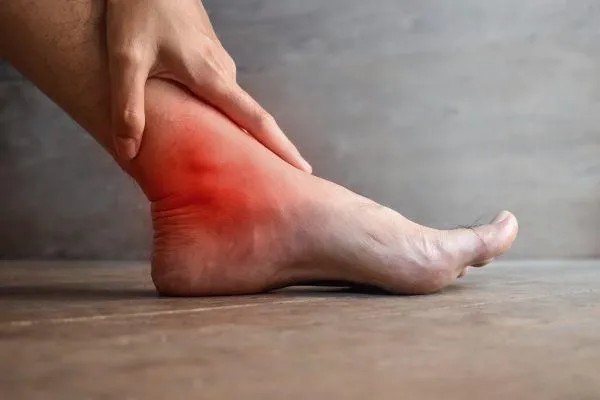
Understanding Ankle Pain: Common Causes and How to Treat It
Ankle pain is a common complaint that can interfere with everyday activities, from walking and running to simply standing. Whether it’s caused by an injury, overuse, or an underlying condition, ankle pain can disrupt your life if left untreated. Understanding the causes of this discomfort is the first step toward effective treatment and long-term relief.
Common Causes of Ankle Pain
Sprains and Strains One of the most frequent causes of ankle pain is sprains and strains. A sprain occurs when the ligaments in the ankle are stretched or torn, often as a result of a sudden twist or fall. A strain, on the other hand, involves the muscles or tendons being overstretched or torn. Both conditions are common in athletes and active individuals but can also happen during everyday activities, such as stepping on an uneven surface.
Achilles Tendonitis The Achilles tendon is the large tendon at the back of the ankle that connects the calf muscles to the heel. Achilles tendonitis is an inflammation of this tendon, often caused by repetitive stress, overuse, or sudden increases in activity intensity. This condition is common in runners or anyone who engages in activities that put strain on the lower legs.
Arthritis Arthritis can also cause chronic ankle pain, especially in older adults. Osteoarthritis, in particular, can wear down the cartilage in the ankle joint, causing pain, swelling, and stiffness. The constant wear and tear of the joint can make it difficult to move without discomfort. Rheumatoid arthritis, another form of arthritis, can also affect the ankle joint and cause similar symptoms.
Fractures Ankle fractures occur when one or more bones in the ankle are broken, often due to a fall, car accident, or sports injury. While fractures are often more severe than sprains or strains, they can lead to long-term problems if not treated properly. Signs of a fracture include severe pain, swelling, bruising, and difficulty bearing weight on the affected foot.
Bursitis Bursitis is the inflammation of the bursae, which are small fluid-filled sacs that cushion the bones, tendons, and muscles around the joints. In the ankle, bursitis can result from repetitive motion or pressure on the joint. It often causes swelling, tenderness, and difficulty moving the ankle comfortably.
Tendinitis Tendinitis occurs when the tendons in the ankle become inflamed. This can happen due to repetitive stress from overuse, leading to discomfort, swelling, and difficulty moving the joint. Tendinitis is often seen in athletes but can occur in anyone who performs repetitive movements.
How to Treat Ankle Pain
Treating ankle pain depends on the underlying cause, but most treatments aim to reduce pain, restore movement, and prevent further injury. Below are some common treatment methods that can help alleviate discomfort and promote healing.
Rest and Ice When you first experience ankle pain, it’s important to rest the affected ankle and avoid putting weight on it. Ice can also help reduce swelling and numb the pain. Apply ice for 15-20 minutes several times a day during the first 48 hours after injury.
Elevation and Compression Elevating the ankle above the level of the heart can help reduce swelling. Using an elastic bandage to wrap the ankle gently can provide compression, which also helps reduce swelling and supports the injured area.
Physiotherapy Physiotherapy plays a crucial role in recovering from ankle injuries. A physiotherapist can provide exercises to strengthen the muscles around the ankle, improve range of motion, and restore balance. Manual therapies, such as joint mobilization, may also be used to improve mobility and reduce pain.
Stretching and Strengthening Regular stretching and strengthening exercises can help improve the flexibility of the ankle and build the strength needed to prevent future injuries. Calf stretches, ankle circles, and resistance band exercises are often recommended for strengthening and improving mobility.
Footwear Adjustments Wearing the right shoes is essential for preventing and treating ankle pain. Poorly fitting shoes or those that don’t provide adequate support can exacerbate pain and lead to further injury. Ensure that your shoes provide proper arch support, cushioning, and fit to reduce strain on the ankle.
Anti-inflammatory Medications Non-steroidal anti-inflammatory drugs (NSAIDs) can help reduce pain and inflammation caused by ankle injuries or conditions like arthritis. However, it’s important to use these medications as directed and consult with a healthcare provider for proper dosage and advice.
Surgery (in Severe Cases) In cases of severe injury, such as fractures or advanced arthritis, surgery may be necessary to repair damaged bones, ligaments, or tendons. Surgical options can help restore function and relieve chronic pain when conservative treatments aren’t effective.
Preventing Future Ankle Pain
Once you’ve treated your ankle pain and are on the road to recovery, it’s important to take steps to prevent further issues. This includes maintaining a regular exercise routine that strengthens the muscles around the ankle, using proper footwear, and paying attention to your body mechanics to avoid unnecessary strain on the joint.
Conclusion
Ankle pain can significantly affect your quality of life, but with the right treatment, most cases can be effectively managed. Whether you’re dealing with an injury, arthritis, or tendinitis, seeking professional treatment and following a rehabilitation plan can help you get back to your activities without the burden of pain.
If you're experiencing ankle pain or want to learn more about how physiotherapy can help, get in touch with us at Take Control Active Rehab. We’re here to help you move better and live pain-free.



